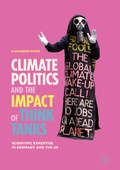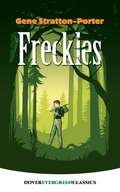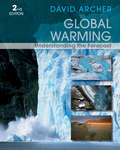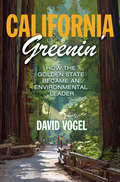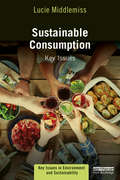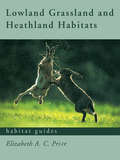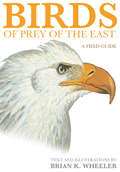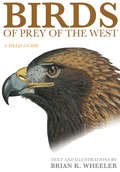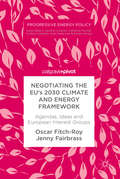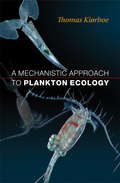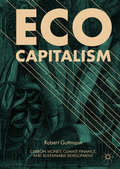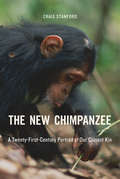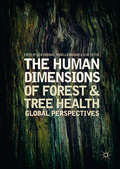- Table View
- List View
Climate Politics and the Impact of Think Tanks: Scientific Expertise in Germany and the US
by Alexander RuserThis book provides an innovative theoretical and analytical framework for studying the role and impact of specialized research organizations and consultancies on decision making in climate politics. It includes advanced empirical analysis of the case of Germany, compared with the situation in the USA. The book improves the understanding of the role and impact of ‘scientific’ advice in coping with the challenge of anthropogenic climate change.
Freckles
by Gene Stratton-PorterIn this companion book to the much-loved classic A Girl of the Limberlost, an orphaned teenager longs to find his place in the world. Freckles was discovered on the doorstep of a Chicago orphanage, badly beaten and missing a hand. He yearns for the fulfillment of useful work, and at Indiana's Limberlost Swamp, his grit and determination win him the difficult, dangerous job of guarding a valuable stand of timber. Faithful and brave in his daily tasks, Freckles comes to appreciate the beauty and majesty of the natural world amid the wetlands' sights, sounds, and silences.As nature works miracles in the boy's lonely, starved heart, Freckles meets a kind and gentle girl who collects specimens for a wildlife photographer. Despite his growing love for his Swamp Angel, Freckles feels himself far below her station — until the opportunity arises for him to prove his true worth.
Global Warming: Understanding the Forecast
by David ArcherBased on the author's highly successful undergraduate course taught at the University of Chicago, Global Warming presents the processes of climate change and climate stability. Drawing on a wide range of disciplines, this Second Edition not only summarizes scientific evidence, but also presents economic and political issues related to global warming.
California Greenin': How the Golden State Became an Environmental Leader (Princeton Studies in American Politics: Historical, International, and Comparative Perspectives #157)
by David VogelA political history of environmental policy and regulation in California, from the Gold Rush to the presentOver the course of its 150-year history, California has successfully protected its scenic wilderness areas, restricted coastal oil drilling, regulated automobile emissions, preserved coastal access, improved energy efficiency, and, most recently, addressed global climate change. How has this state, more than any other, enacted so many innovative and stringent environmental regulations over such a long period of time? The first comprehensive look at California's history of environmental leadership, California Greenin' shows why the Golden State has been at the forefront in setting new environmental standards, often leading the rest of the nation.From the establishment of Yosemite, America's first protected wilderness, and the prohibition of dumping gold-mining debris in the nineteenth century to sweeping climate- change legislation in the twenty-first, David Vogel traces California's remarkable environmental policy trajectory. He explains that this pathbreaking role developed because California had more to lose from environmental deterioration and more to gain from preserving its stunning natural geography. As a result, citizens and civic groups effectively mobilized to protect and restore their state's natural beauty and, importantly, were often backed both by business interests and bystrong regulatory authorities. Business support for environmental regulation in California reveals that strict standards are not only compatible with economic growth but can also contribute to it. Vogel also examines areas where California has fallen short, particularly in water management and the state's dependence on automobile transportation. As environmental policy debates continue to grow more heated, California Greenin' demonstrates that the Golden State's impressive record of environmental accomplishments holds lessons not just for the country but for the world.
California Greenin': How the Golden State Became an Environmental Leader (Princeton Studies in American Politics: Historical, International, and Comparative Perspectives #157)
by David VogelA political history of environmental policy and regulation in California, from the Gold Rush to the presentOver the course of its 150-year history, California has successfully protected its scenic wilderness areas, restricted coastal oil drilling, regulated automobile emissions, preserved coastal access, improved energy efficiency, and, most recently, addressed global climate change. How has this state, more than any other, enacted so many innovative and stringent environmental regulations over such a long period of time? The first comprehensive look at California's history of environmental leadership, California Greenin' shows why the Golden State has been at the forefront in setting new environmental standards, often leading the rest of the nation.From the establishment of Yosemite, America's first protected wilderness, and the prohibition of dumping gold-mining debris in the nineteenth century to sweeping climate- change legislation in the twenty-first, David Vogel traces California's remarkable environmental policy trajectory. He explains that this pathbreaking role developed because California had more to lose from environmental deterioration and more to gain from preserving its stunning natural geography. As a result, citizens and civic groups effectively mobilized to protect and restore their state's natural beauty and, importantly, were often backed both by business interests and bystrong regulatory authorities. Business support for environmental regulation in California reveals that strict standards are not only compatible with economic growth but can also contribute to it. Vogel also examines areas where California has fallen short, particularly in water management and the state's dependence on automobile transportation. As environmental policy debates continue to grow more heated, California Greenin' demonstrates that the Golden State's impressive record of environmental accomplishments holds lessons not just for the country but for the world.
Big Pacific: Passionate, Voracious, Mysterious, Violent
by Rebecca TansleyThe Pacific Ocean covers one-third of Earth’s surface—more than all of the planet’s landmasses combined. It contains half of the world’s water, hides its deepest places, and is home to some of the most dazzling creatures known to science. The companion book to the spectacular five-part series on PBS produced by Natural History New Zealand, Big Pacific breaks the boundaries between land and sea to present the Pacific Ocean and its inhabitants as you have never seen them before.Illustrated in full color throughout, Big Pacific blends a wealth of stunning Ultra HD images with spellbinding storytelling to take you into a realm teeming with exotic life rarely witnessed up close—until now. The book is divided into four sections, each one focusing on an aspect of the Pacific. "Passionate Pacific" looks at the private lives of sea creatures, with topics ranging from the mating behaviors of great white sharks to the monogamy of wolf eels, while "Voracious Pacific" covers hunting and feeding. In "Mysterious Pacific," you will be introduced to the Pacific’s more extraordinary creatures, like the pufferfish and firefly squid, and explore some of the region’s eerier locales, like the turtle tombs of Borneo and the skull caves of Papua New Guinea. "Violent Pacific" examines the effects of events like natural disasters on the development of the Pacific Ocean’s geography and the evolution of its marine life.Providing an unparalleled look at a diverse range of species, locations, and natural phenomena, Big Pacific is truly an epic excursion to one of the world’s last great frontiers.Five-part series on PBS:Big Pacific will air Wednesdays on PBS, June 21-July 19, 2017
Sustainable Consumption: Key Issues (Key Issues in Environment and Sustainability)
by Lucie MiddlemissSustainable Consumption: Key Issues provides a concise introduction to the field of sustainable consumption, outlining the contribution of the key disciplines in this multi-disciplinary area, and detailing the way in which both the problem and the potential for solutions are understood. Divided into three key parts, the book begins by introducing the concept of sustainable consumption, outlining the environmental impacts of current consumption trends, and placing these impacts in social context. The central section looks at six contrasting explanations of sustainable consumption in the public domain, detailing the stories that are told about why people act in the way they do. This section also explores the theory and evidence around each of these stories, linking them to a range of disciplines and approaches in the social sciences. The final section takes a broader look at the solutions proposed by sustainable consumption scholars and practitioners, outlining the visions of the future that are put forward to counteract damage to environment and society. Each chapter highlights key authors and real-world examples to encourage students to broaden their understanding of the topic and to think critically about how their daily lives intersect with environmental and ethical issues. Exploring the ways in which critical thinking and an understanding of sustainable consumption can be used in daily life as well as in professional practice, this book is essential reading for students, academics, professionals and policy-makers with an interest in this growing field.
Lowland Grassland and Heathland Habitats (Habitat Guides)
by Elizabeth PriceGrasslands are everywhere: agricultural land, playing fields and road verges; but while species-poor, intensively managed grasslands are widespread, colourful semi-natural grasslands and heathlands, buzzing with life, are scarce. These semi-natural habitats are ancient, cultural landscapes, which are of considerable, if not international importance for biodiversity. However, despite targets for the conservation and restoration of these valuable grasslands and heathlands, these habitats continue to decline before our eyes. Lowland Grassland and Heathland Habitats contrasts the uniformity of intensively managed grassland with the diversity of traditionally managed grasslands and heathlands. It examines topics of concern to the ecologist or habitat manager such as causes of the loss and deterioration of these habitats, including inappropriate management, eutrophication and climate change. It then evaluates opportunities for positive change, such as conservation, restoration and creation. A series of case-studies illustrates the pressures on some lowland grassland and heathland habitat types and looks at ways to enhance them for biodiversity. This habitat guide features illustrated species boxes of typical plants and animals, as well as a full species list, a series of projects on the ecology of grassland and heathland species, a colour plate section, up-to-date references and information, and a full glossary. It will provide students and environmentalists with a deeper understanding of the nature and importance of lowland grasslands and heathlands.
Lowland Grassland and Heathland Habitats (Habitat Guides)
by Elizabeth PriceGrasslands are everywhere: agricultural land, playing fields and road verges; but while species-poor, intensively managed grasslands are widespread, colourful semi-natural grasslands and heathlands, buzzing with life, are scarce. These semi-natural habitats are ancient, cultural landscapes, which are of considerable, if not international importance for biodiversity. However, despite targets for the conservation and restoration of these valuable grasslands and heathlands, these habitats continue to decline before our eyes. Lowland Grassland and Heathland Habitats contrasts the uniformity of intensively managed grassland with the diversity of traditionally managed grasslands and heathlands. It examines topics of concern to the ecologist or habitat manager such as causes of the loss and deterioration of these habitats, including inappropriate management, eutrophication and climate change. It then evaluates opportunities for positive change, such as conservation, restoration and creation. A series of case-studies illustrates the pressures on some lowland grassland and heathland habitat types and looks at ways to enhance them for biodiversity. This habitat guide features illustrated species boxes of typical plants and animals, as well as a full species list, a series of projects on the ecology of grassland and heathland species, a colour plate section, up-to-date references and information, and a full glossary. It will provide students and environmentalists with a deeper understanding of the nature and importance of lowland grasslands and heathlands.
Birds of Prey of the East: A Field Guide
by Brian K. WheelerBirds of Prey of the East and its companion volume, Birds of Prey of the West, are the most comprehensive and authoritative field guides to North American birds of prey ever published. Written and lavishly illustrated with stunning, lifelike paintings by leading field-guide illustrator, photographer, and author Brian Wheeler, the guides depict an enormous range of variations of age, sex, color, and plumage, and feature a significant amount of plumage data that has never been published before. The painted figures illustrate plumage and species comparisons in a classic field-guide layout. Each species is shown in the same posture and from the same viewpoint, which further assists comparisons. Facing-page text includes quick-reference identification points and brief natural history accounts that incorporate the latest information. The range maps are exceptionally accurate and much larger than those in other guides. They plot the most up-to-date distribution information for each species and include the location of cities for more accurate reference. Finally, the guides feature color habitat photographs next to the maps. The result sets a new standard for guides to North America's birds of prey.Lavishly illustrated with stunning, lifelike paintingsWritten and illustrated by a leading authority on North American birds of preyDepicts more plumages than any other guideConcise facing-page text includes quick-reference identification pointsClassic field-guide layout makes comparing species easyLarge, accurate range maps include up-to-date distribution informationUnique color habitat photographs next to the maps
Birds of Prey of the East: A Field Guide
by Brian K. WheelerBirds of Prey of the East and its companion volume, Birds of Prey of the West, are the most comprehensive and authoritative field guides to North American birds of prey ever published. Written and lavishly illustrated with stunning, lifelike paintings by leading field-guide illustrator, photographer, and author Brian Wheeler, the guides depict an enormous range of variations of age, sex, color, and plumage, and feature a significant amount of plumage data that has never been published before. The painted figures illustrate plumage and species comparisons in a classic field-guide layout. Each species is shown in the same posture and from the same viewpoint, which further assists comparisons. Facing-page text includes quick-reference identification points and brief natural history accounts that incorporate the latest information. The range maps are exceptionally accurate and much larger than those in other guides. They plot the most up-to-date distribution information for each species and include the location of cities for more accurate reference. Finally, the guides feature color habitat photographs next to the maps. The result sets a new standard for guides to North America's birds of prey.Lavishly illustrated with stunning, lifelike paintingsWritten and illustrated by a leading authority on North American birds of preyDepicts more plumages than any other guideConcise facing-page text includes quick-reference identification pointsClassic field-guide layout makes comparing species easyLarge, accurate range maps include up-to-date distribution informationUnique color habitat photographs next to the maps
Birds of Prey of the West: A Field Guide
by Brian K. WheelerBirds of Prey of the West and its companion volume, Birds of Prey of the East, are the most comprehensive and authoritative field guides to North American birds of prey ever published. Written and lavishly illustrated with stunning, lifelike paintings by leading field-guide illustrator, photographer, and author Brian Wheeler, the guides depict an enormous range of variations of age, sex, color, and plumage, and feature a significant amount of plumage data that has never been published before. The painted figures illustrate plumage and species comparisons in a classic field-guide layout. Each species is shown in the same posture and from the same viewpoint, which further assists comparisons. Facing-page text includes quick-reference identification points and brief natural history accounts that incorporate the latest information. The range maps are exceptionally accurate and much larger than those in other guides. They plot the most up-to-date distribution information for each species and include the location of cities for more accurate reference. Finally, the guides feature color habitat photographs next to the maps. The result sets a new standard for guides to North America's birds of prey.Lavishly illustrated with stunning, lifelike paintingsWritten and illustrated by a leading authority on North American birds of preyDepicts more plumages than any other guideConcise facing-page text includes quick-reference identification pointsClassic field-guide layout makes comparing species easyLarge, accurate range maps include up-to-date distribution informationUnique color habitat photographs next to the maps
Birds of Prey of the West: A Field Guide
by Brian K. WheelerBirds of Prey of the West and its companion volume, Birds of Prey of the East, are the most comprehensive and authoritative field guides to North American birds of prey ever published. Written and lavishly illustrated with stunning, lifelike paintings by leading field-guide illustrator, photographer, and author Brian Wheeler, the guides depict an enormous range of variations of age, sex, color, and plumage, and feature a significant amount of plumage data that has never been published before. The painted figures illustrate plumage and species comparisons in a classic field-guide layout. Each species is shown in the same posture and from the same viewpoint, which further assists comparisons. Facing-page text includes quick-reference identification points and brief natural history accounts that incorporate the latest information. The range maps are exceptionally accurate and much larger than those in other guides. They plot the most up-to-date distribution information for each species and include the location of cities for more accurate reference. Finally, the guides feature color habitat photographs next to the maps. The result sets a new standard for guides to North America's birds of prey.Lavishly illustrated with stunning, lifelike paintingsWritten and illustrated by a leading authority on North American birds of preyDepicts more plumages than any other guideConcise facing-page text includes quick-reference identification pointsClassic field-guide layout makes comparing species easyLarge, accurate range maps include up-to-date distribution informationUnique color habitat photographs next to the maps
Negotiating the EU’s 2030 Climate and Energy Framework: Agendas, Ideas and European Interest Groups (Progressive Energy Policy)
by Oscar Fitch-Roy Jenny FairbrassIn 2014, European heads of state selected new targets for the EU as part of the 2030 climate and energy framework. These targets will guide the ambition and nature of EU policy in this area until 2030 and are likely to have important implications for Europe’s transition to a low-carbon economy. This book exposes the role of civil society and business interest groups in setting the policymaking agenda and defining the range of options for the framework. Based on a unique sample of 32 in-depth interviews with Brussels policy elites, this book casts EU interest representation in a new light. In a novel application of the ‘multiple streams approach’, sequential chapters present the problems faced by policymakers, the range of policy options available to address them and the political constraints within which policy entrepreneurs attempted to attached policies to problems.
Negotiating the EU’s 2030 Climate and Energy Framework: Agendas, Ideas and European Interest Groups (Progressive Energy Policy)
by Oscar Fitch-Roy Jenny FairbrassIn 2014, European heads of state selected new targets for the EU as part of the 2030 climate and energy framework. These targets will guide the ambition and nature of EU policy in this area until 2030 and are likely to have important implications for Europe’s transition to a low-carbon economy. This book exposes the role of civil society and business interest groups in setting the policymaking agenda and defining the range of options for the framework. Based on a unique sample of 32 in-depth interviews with Brussels policy elites, this book casts EU interest representation in a new light. In a novel application of the ‘multiple streams approach’, sequential chapters present the problems faced by policymakers, the range of policy options available to address them and the political constraints within which policy entrepreneurs attempted to attached policies to problems.
A Mechanistic Approach to Plankton Ecology
by Thomas KiørboeThe three main missions of any organism--growing, reproducing, and surviving--depend on encounters with food and mates, and on avoiding encounters with predators. Through natural selection, the behavior and ecology of plankton organisms have evolved to optimize these tasks. This book offers a mechanistic approach to the study of ocean ecology by exploring biological interactions in plankton at the individual level. The book focuses on encounter mechanisms, since the pace of life in the ocean intimately relates to the rate at which encounters happen. Thomas Kiørboe examines the life and interactions of plankton organisms with the larger aim of understanding marine pelagic food webs. He looks at plankton ecology and behavior in the context of the organisms' immediate physical and chemical habitats. He shows that the nutrient uptake, feeding rates, motility patterns, signal transmissions, and perception of plankton are all constrained by nonintuitive interactions between organism biology and small-scale physical and chemical characteristics of the three-dimensional fluid environment. Most of the book's chapters consist of a theoretical introduction followed by examples of how the theory might be applied to real-world problems. In the final chapters, mechanistic insights of individual-level processes help to describe broader population dynamics and pelagic food web structure and function.
Eco-Capitalism: Carbon Money, Climate Finance, And Sustainable Development
by Robert GuttmannOur planet faces a systemic threat from climate change, which the world community of nations is ill-prepared to address, and this book argues that a new form of ecologically conscious capitalism is needed in order to tackle this serious and rising threat. While the Paris Climate Agreement of 2015 has finally implemented a global climate policy regime, its modest means belie its ambitious goals. Our institutional financial organizations are not equipped to deal with the problems that any credible commitment to a low-carbon economy will have to confront. We will have to go beyond cap-and-trade schemes and limited carbon taxes to cut greenhouse gas emissions substantially in due time. This book offers a way forward toward that goal, with a conceptual framework that brings environmental preservation back into our macro-economic growth and forecasting models. This framework obliges firms to consider other goals beyond shareholder value maximization, outlining the principal tenets of a climate-friendly finance and introducing a new type of money linked to climate mitigation and adaptation efforts.
Alexander Wilson: The Scot Who Founded American Ornithology
by Edward H. Burtt Jr.On the bicentennial of his death, this beautifully illustrated volume pays tribute to the Scot who became the father of American ornithology. Alexander Wilson made unique contributions to ecology and animal behavior. His drawings of birds in realistic poses in their natural habitat inspired Audubon, Spencer Fullerton Baird, and other naturalists.
After Nature: A Politics for the Anthropocene
by Jedediah PurdyNature no longer exists apart from humanity. The world we will inhabit is the one we have made. Geologists call this epoch the Anthropocene, Age of Humans. The facts of the Anthropocene are scientific—emissions, pollens, extinctions—but its shape and meaning are questions for politics. Jedediah Purdy develops a politics for this post-natural world.
The Mortal Sea: Fishing The Atlantic In The Age Of Sail
by W. Jeffrey BolsterSince the time of the Vikings, the Atlantic has shaped the lives of people who depend on it for survival, and people have shaped the Atlantic. In his account of this interdependency, Bolster, a historian and professional seafarer, takes us through a millennium-long environmental history of our impact on one of the largest ecosystems in the world.
Animal Kingdoms: Hunting, The Environment, And Power In The Indian Princely States
by Julie E. HughesAnimal Kingdoms reveals the far-reaching cultural, political, and environmental importance of hunting in colonial India. Julie E. Hughes explores how Indian princes relied on their prowess as hunters of prized game to advance personal status, solidify power, and establish links with the historic battlefields and legendary deeds of their ancestors.
The New Chimpanzee: A Twenty-First-Century Portrait of Our Closest Kin
by Craig StanfordRecent discoveries about wild chimpanzees have dramatically reshaped our understanding of these great apes and their kinship with humans. We now know that chimpanzees not only have genomes similar to our own but also plot political coups, wage wars over territory, pass on cultural traditions to younger generations, and ruthlessly strategize for resources, including sexual partners. In The New Chimpanzee, Craig Stanford challenges us to let apes guide our inquiry into what it means to be human. With wit and lucidity, Stanford explains what the past two decades of chimpanzee field research has taught us about the origins of human social behavior, the nature of aggression and communication, and the divergence of humans and apes from a common ancestor. Drawing on his extensive observations of chimpanzee behavior and social dynamics, Stanford adds to our knowledge of chimpanzees’ political intelligence, sexual power plays, violent ambition, cultural diversity, and adaptability. The New Chimpanzee portrays a complex and even more humanlike ape than the one Jane Goodall popularized more than a half century ago. It also sounds an urgent call for the protection of our nearest relatives at a moment when their survival is at risk.
The Human Dimensions of Forest and Tree Health: Global Perspectives
by Clive Potter Julie Urquhart Mariella MarzanoThis book explores the specifically human dimensions of the problem posed by a new generation of invasive pests and pathogens to tree health worldwide. The growth in global trade and transportation in recent decades, along with climate change, is allowing invasive pests and pathogens to establish in new environments, with profound consequences for the ecosystem services provided by trees and forests, and impacts on human wellbeing. The central theme of the book is to consider the role that social science can play in better understanding the social, economic and environmental impacts of such tree disease and pest outbreaks. Contributions include explorations of how pest outbreaks are socially constructed, drawing on the historical, cultural, social and situated contexts of outbreaks; the governance and economics of tree health for informing policy and decision-making; stakeholder engagement and communication tools; along with more philosophical approaches that draw on environmental ethics to consider ‘non-human’ perspectives. Taken together the book makes theoretical, methodological and applied contributions to our understanding of this important subject area and encourages researchers from across the social sciences and humanities to bring their own disciplinary perspectives and expertise to address the complexity that is the human dimensions of forest and tree health.Chapters 5 and 11 are open access under a CC BY 4.0 license via link.springer.com.
The Human Dimensions of Forest and Tree Health: Global Perspectives
by Clive Potter Julie Urquhart Mariella MarzanoThis book explores the specifically human dimensions of the problem posed by a new generation of invasive pests and pathogens to tree health worldwide. The growth in global trade and transportation in recent decades, along with climate change, is allowing invasive pests and pathogens to establish in new environments, with profound consequences for the ecosystem services provided by trees and forests, and impacts on human wellbeing. The central theme of the book is to consider the role that social science can play in better understanding the social, economic and environmental impacts of such tree disease and pest outbreaks. Contributions include explorations of how pest outbreaks are socially constructed, drawing on the historical, cultural, social and situated contexts of outbreaks; the governance and economics of tree health for informing policy and decision-making; stakeholder engagement and communication tools; along with more philosophical approaches that draw on environmental ethics to consider ‘non-human’ perspectives. Taken together the book makes theoretical, methodological and applied contributions to our understanding of this important subject area and encourages researchers from across the social sciences and humanities to bring their own disciplinary perspectives and expertise to address the complexity that is the human dimensions of forest and tree health.Chapters 5 and 11 are open access under a CC BY 4.0 license via link.springer.com.
Crossing the Bay of Bengal: The Furies Of Nature And The Fortunes Of Migrants
by Sunil S. AmrithFor centuries the Bay of Bengal served as a maritime highway between India and China, and as a battleground for European empires, while being shaped by monsoons and human migration. Integrating environmental history and mining a wealth of sources, Sunil S. Amrith offers insights to the many challenges facing Asia in the decades ahead.
